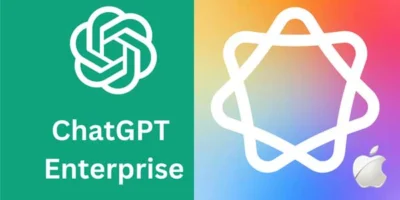
Cupertino, CA - Aug 23, 2025 (UTC) - Apple is significantly expanding its enterprise artificial intelligence offerings with new tools that will give businesses unprecedented control over how their employees access AI services. The company announced plans to introduce configurable ChatGPT Enterprise integration alongside broader device management enhancements as part of its September software updates, marking a strategic push into the lucrative enterprise AI market. The move comes as businesses increasingly demand granular control over AI deployment while maintaining strict data privacy and compliance standards. Apple’s modular approach also sets the stage for potential partnerships with other major AI providers, positioning the company as a flexible platform rather than being locked into a single AI ecosystem.
ChatGPT Enterprise Integration with Flexible Controls
With the upcoming iOS 26 update arriving in September, Apple will add the ability for IT administrators to configure enterprise versions of OpenAI’s ChatGPT service. Apple has already seen the demand for ChatGPT for Enterprise, which OpenAI says now has over 5 million business customers who use the AI service to connect with their own internal data when using AI agents.
The enterprise version offers different privacy settings, higher usage limits, as well as extra features such as company data integration compared to the consumer version. This addresses growing demand from businesses that want to leverage AI capabilities while maintaining control over sensitive corporate data and compliance requirements.
In addition to letting businesses pick and choose which AI features to enable, this setup allows businesses to decide whether employees’ AI requests can go to ChatGPT’s cloud service, even when the business doesn’t have its own enterprise deal with OpenAI.
Strategic Architecture for Future AI Partnerships
What makes Apple’s approach particularly notable is its forward-thinking technical architecture. Apple’s support documents indicate that IT administrators will be able to restrict or allow any “external” artificial intelligence provider, not just OpenAI’s technology.
This modular design leaves the door open for Apple to forge deals with other major AI players used in enterprise environments, including Anthropic, Google, and Microsoft, without requiring fundamental system changes. That leaves the door open for Apple to forge other deals with large AI players used in the enterprise environment, without having to recode things at the protocol level.
Balancing Privacy and Functionality
Apple’s approach reflects its understanding that enterprise adoption of AI requires careful consideration of data privacy and security concerns. While the company fully believes in its Private Cloud Compute architecture, it knows that it can take time for companies to agree to make changes to sensitive systems and data.
The new system allows businesses to decide whether data should be processed in the cloud or on-device, giving companies flexibility to meet their specific security and compliance requirements. This granular control addresses a key barrier to enterprise AI adoption, where companies often have strict policies about where sensitive data can be processed.
Broader Enterprise Management Enhancements
Beyond AI capabilities, Apple is rolling out comprehensive improvements to its enterprise device management ecosystem:
Apple Business Manager API
Apple will launch an API for its Apple Business Manager service, enabling integration with existing IT infrastructure. This will allow the service’s functions to be incorporated into other IT tools, including Mobile Device Management (MDM) products, inventory management services, and help desk systems.
Enhanced Device Management
New Device Management tools will simplify the process of migrating devices to different management services, a capability that becomes particularly valuable during mergers and acquisitions when companies need to transition employee devices and assets between systems.
Improved Return to Service Solution
Apple’s Return to Service solution, which enables quick device wiping and preparation for new users, will now offer the option to leave all applications installed. This enhancement saves significant time and bandwidth since IT administrators and users won’t need to reinstall applications from scratch. The service will also become available for Vision Pro devices for the first time.
Advanced Authentication Options
For shared Mac environments, Apple is introducing an authenticated Guest Mode that allows employees to log in using credentials from their identity provider, with personal data automatically erased upon logout while preserving installed applications. Additionally, businesses can now add NFC readers to Mac computers, enabling employees to log in simply by tapping their Apple Watch or iPhone.
Enterprise AI Market Context
Apple’s expansion into configurable enterprise AI comes at a critical time as businesses increasingly seek to integrate artificial intelligence into their workflows while maintaining security and compliance standards. The move positions Apple to compete more effectively with established enterprise technology providers who have been offering similar AI integration capabilities.
The timing also coincides with broader developments in Apple’s AI strategy. With the upcoming iOS 26 update, Apple will add “the ability to configure the use of an enterprise version of OpenAI’s ChatGPT,” which offers different privacy settings, higher usage limits, as well as extra features such as company data integration.
Technical Implementation Details
The integration takes advantage of Apple Intelligence’s existing architecture, where requests never go from Apple’s cloud to ChatGPT directly — it’s either/or — it’s easier to disable the ChatGPT setting. This design simplifies the process for IT administrators to control when and how external AI services are accessed.
The system allows for granular control at the device level, enabling administrators to specify which employees can access AI features and under what conditions. For instance, companies could restrict usage to certain applications or data sets, ensuring that sensitive information doesn’t inadvertently leave the corporate environment.
Future Outlook and Industry Implications
Apple’s modular approach to enterprise AI integration represents a significant shift in how the company is approaching business customers. By building a system that can accommodate multiple AI providers, Apple is positioning itself as a platform that can adapt to changing enterprise preferences and partnerships.
This strategy also reflects the competitive reality of the enterprise AI market, where businesses often prefer to work with multiple providers rather than being locked into a single AI ecosystem. Apple’s approach allows companies to maintain flexibility while benefiting from the integration and management capabilities of Apple’s enterprise tools.
The September rollout will provide the first real-world test of how successfully Apple can compete in the enterprise AI space, where it faces established players like Microsoft, Google, and specialized enterprise AI companies that have been building business-focused solutions for years.
Availability and Implementation
All of these new enterprise features will roll out in September as part of Apple’s broader software updates for iPhone, iPad, Mac, and other devices. The timing aligns with Apple’s traditional fall software release cycle and positions the company to capture enterprise budget cycles that typically conclude in the fourth quarter.
For businesses already using Apple devices, the new AI configuration options will be available through existing Mobile Device Management systems, making adoption relatively straightforward for IT departments already familiar with Apple’s enterprise tools.





